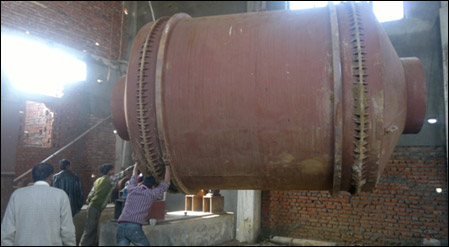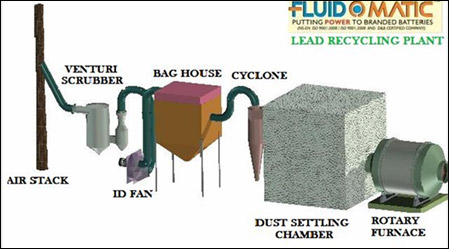Lead to be manufactured from Rotary Furnace can be
obtained directly from scrapped batteries or as slag from Mini Blast
Furnaces In case of former batteries are cut open or broken to segregate
lead scrap, plastic and other materials from them;lead scrap in the form of
lead powder/ plates etc. is charged in the furnace along with a
proportionate charge of additives. InThe case of latter, slag produced from
Mini Blast Furnaces is charged into the Rotary Furnace, again with
proportionate additives.
This process is a batch type process. After filling the required quantity
of raw material (either manually or mechanically), thelid of the furnace at
the front is closed. The burner attached to the moving door is then fired.
The Rotary Melting Furnace is very flexible and
universal equipment used for recycling many non-ferrous metals. It is
themajor lead production technology used in India and many other countries
for Secondary Lead Production. A lead production system based on this
technology has certain distinct characteristics such as:
- Equipment scalable for installing higher capacities
- Recovers all lead in one production cycle
- Plates & powder from scrap battery as well as slag from Mini
Blast Furnace can be used as raw material
- Requires addition of certain consumables
- Can be fired with various fuels
- Generates high Pollution both as Flue Gases & Fugitive Emissions
Apart from plates and paste of lead oxide from
scrap batteries, slag from Mini Blast Furnace is charged in the Rotary
Furnace.
In addition to these, certain compounds of sulphur are also present in the
batteries. When this material is heated in thePresence of carbon, lead oxide
is converted to lead. This conversion along with burning of fuel generates
flue gases and fumescontaining dust, dirt, oxides of lead, lead particles
and such other impurities etc.
Hence, to meet various goals of maintaining employees' health and factory
environments as well as regulatory requirements,it becomes imperative to get
high end Air Pollution Control Systems to be installed with the Rotary
Furnaces.
Rotary Chamber receives very hot gases from Rotary
Furnace while cold gases from atmosphere are induced into chambervia
specially designed profile. Thus chamber works as an equalizing chamber to
reduce the temperature of gases and alsowhere sedimentation of dust
particulate matter takes place.
Rotary Chamber Advantages
- Recovers 100% lead in the first operation.
- Slag produced is lead free.
- Equipment can be scaled up for higher production capacities.
- Many chemicals are required for operation.
- High power consumption.
Rotary Chamber Disadvantages
- Difficult to produce low Antimony lead suitable for soft lead
purposes.
- Fugitive Emissions need to be captured in addition to flue gases.
- Need skilled operators and careful maintenance.
Tapping of Rotary Furnace also lead to generation of
Fugitive Emissions which need to be captured at source and treated to
maintain ambient air standards at workplace. Air Pollution Control Device
for Rotary Furnace
- Dust : Less than 50 mg / Nm
- Lead (Pb) : Less than 10 mg / Nm
- Temperature : 60-90 C
- Gases : Traces of NOx and SO2








